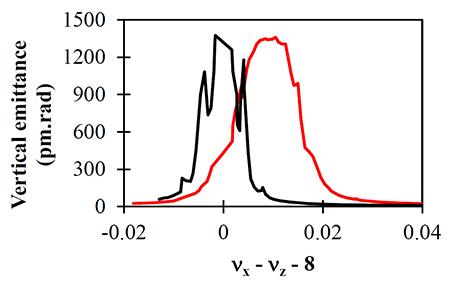In a storage ring, an electron beam interacts with the vacuum chamber, generating wake fields that act back on the beam itself. The main effect of these fields is to limit the stored current because high current beams are excited up to the explosion that makes them lost. The use of the Transverse Feedback (TFB) allows alleviating this beam current limitation. In addition, for the special case of flat chambers, the wake fields introduce some incoherent focusing, proportional to the beam current, which modifies significantly the transverse tuning of the machine and can affect the performance in terms of beam lifetime and injection efficiency. Some exhaustive and innovative measurements have been performed at SOLEIL by the Accelerator Physics group, to study this incoherent focusing, especially for the case of high current bunches. The results are published in “Physical Review Accelerators and Beams”.
Incoherent wake fields are generated from a high current beam circulating in flat chambers or in-vacuum undulators, due to the proximity of metallic walls. The so-called resistive-wall field remains in a flat chamber due to the non-circular geometry of the cross section. The main component of the residual field is known to be quadrupolar acting incoherently similar to a quadrupole magnet, with a focusing strength that depends linearly on the beam current. This means that for electrons in an intense beam, the betatron tunes are significantly shifted from the reference ones in the two transverse planes. This feature raises a particular concern to SOLEIL delivering high bunch intensity modes and must be taken into account in the machine tuning. The impact of these incoherent wake fields was fully measured at SOLEIL in terms of tune shifts for the three distinct ranges of the excited field: the long multi-turn regime in multibunch fillings, the medium regime involving neighboring bunches, and the short intra-bunch regime.
Long multi-turn regime in multibunch fillings
The long multi-turn regime in multibunch fillings was already studied in multibunch at the design phase of the storage ring. In addition the standard orbit response matrix method, measuring the effect of 57 dipolar correctors on the beam position at 122 beam position monitors (BPM) in the transverse planes, was used to identify the location and strength of the quadrupole-like sources. As expected larger gradients were found to be located at both medium and long straight sections where the vertical aperture of the vacuum chamber is smaller.
Medium regime involving neighboring bunches
To investigate the time dependence of the wakes excited by a high current bunch, the tunes of parasitic bunches (15 μA) were measured as a function of their distance from the main bunch. Four parasitic bunches were stored close to the main bunch, both upstream and downstream. Transverse Feedback (TFB) was employed to excite each of the eight parasitic bunches independently to measure their tunes. The detection of weak parasitic bunch signals turned out to be difficult due both to the strong field of the main bunch extending over to the adjacent bunch and to the large kicks of TFB stabilizing the main bunch against head-tail instability.
A large improvement was obtained by replacing the detection BPM by a shorted stripline in order to minimize the cross-talk. For all the parasitic bunches, the measured tune shifts were positive horizontally and negative vertically (Fig. 1). As expected, the tune shifts measured for upstream bunches were small while much larger variations were found for downstream bunches with a maximum value for the first bunch adjacent to the main bunch since it suffers from the largest amplitude of the wake field induced by the main bunch.

Figure 1: Horizontal (red) and vertical (blue) incoherent tune shifts measured for the four upstream (-4 to -1) and downstream (1 to 4) parasitic bunches for a main bunch current of 20 mA.
Short intrabunch regime
The betatron tune shifts measured by shaking a high current bunch consist of two contributions: a coherent shift induced by the dipolar wakes and the incoherent shift to be identified. The standard beam shaking cannot distinguish between the two contributions. The idea is to make use of the betatron coupling resonance νx – νz = 8 to measure the incoherent tune shift because the resonance condition can be identified with high precision by following the maximum vertical beam size with an X-ray pinhole camera. After minimizing the width of the coupling resonance with skew quadrupoles, the horizontal tune was increased to approach the vertical one (kept constant) using a pair of quadrupole families. The vertical emittance of the high current bunch was recorded simultaneously and compared to the one recorded for a low current bunch (Fig. 2).
The vertical emittance is maximized when the machine tunes are on the resonance for a low current bunch and when tunes are still far from the coupling resonance for a high bunch current.
This indicates that the incoherent tunes of the high current bunch are shifted with respect to those of the low current bunch. The experiment was extended to four other different bunch currents and results were compared to calculations (Fig. 3).
This innovative measurements show that the effect of NEG coating is not negligible and that the betatron tune shift with current is 18 times larger in single bunch mode than in multibunch mode. This could explain the different working points required for high bunch current modes of operation as well as their much higher sensitivity to tunes.

Figure 2: Variation of the measured vertical emittance as a function of the distance between fractional parts of the horizontal and vertical tunes for a low current per bunch (black) and a 20 mA current per bunch (red).

Figure 3: Variation of the measured (red square) horizontal incoherent tune shift as a function of bunch current. Comparison with the values expected from theory including NEG coating (blue area) or not (blue dashed line).
